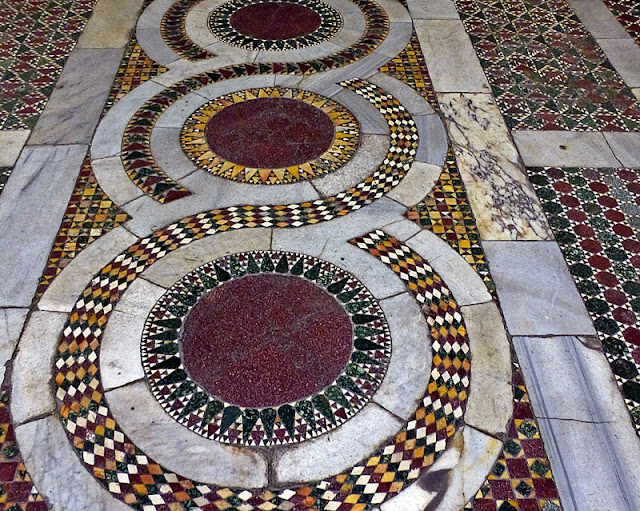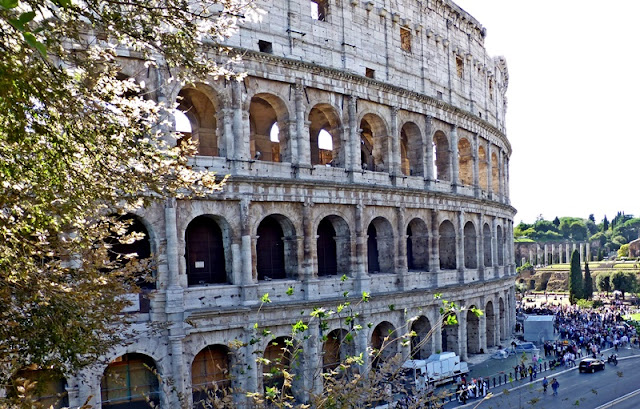Sunday, October 11, 2015
This morning we did another Context tour titled, “Of Cows
and Commerce” which can be found here: https://contexttravel.com/city/rome/walking-tour-details/of-cows-and-commerce
. The thrust of the tour was to
understand the early commerce of Rome along the Tiber. We did indeed learn these things, starting in
the ancient Cow Market on the edge of the river, and learning about the trade
there. But with our guide being an
archeologist, there was considerable focus on the buildings of ancient Rome and
how they were repurposed over time.
Indeed, our focus was more on architecture than on commerce.
Here’s a temple to Portunus, the god of the Port:
And a temple thought probably to be to Hercules:
Across from these is a building which originally was one of
the 60 grain distribution centers which existed in the Republican and Imperial
periods of Rome. Citizens were entitled
to grain simply because they were citizens!
This building had been repurposed as a church, and you can see the
original columns buried in the church walls:
The church has a very beautiful floor which dates from
around 1200:
Today the church is Greek Catholic, something I know nothing
about. There are Greek looking icons in
the church:
In Renaissance times the various guilds all had their own
churches, and we visited the church of the Ironworkers:
Finally we visited a church which had been built atop three
adjacent Roman temples, and in the bowels of the church we were able to see the
construction features. Here’s a drawing
of how it was done:
That was the end of our Context tour, and we walked to the
Jewish Ghetto district for lunch. There
is a bustling street with a number of kosher restaurants. We ate at one:
Following lunch we took a taxi to what we thought was the
entrance to the complex which includes the Coliseum and the Palatine Hill, the
residential area for the elite above the Coliseum. We were off a bit, but ultimately made our
way there. We will tour the Coliseum
with our Melton group, but not the Palatine Hill, so we walked up from the
Coliseum. The Coliseum itself is
astonishing; enormous and very well preserved/reconstructed, it was really busy
on a beautiful Sunday afternoon:
Carvings on the inside of the arch reflect the triumphant
march returning from Jerusalem with the booty from the siege. Prominent is a menorah:
We climbed to the top and explored the remnants of the
palace and the residences. There is a
wonderful breeze up there which probably is delightful on hot summer days, and
the view of the area below is very impressive:
We went back to the hotel, rested a while, and had another
lovely dinner with wine. Tomorrow we
meet up with our Melton group and start that portion of our trip.











Victor - We've bee following your blog with great interest. Rome is an amazing city. Breathtaking sweep of history, impossible buildings from 2000 years past, incredible beauty everywhere, and great food! Your blog brings all this back to us! One fun thing Cath and I did was to sample gelato in all the cities we visited - while all was good, Rome wasn't the best! You will have to tell us your opinion.
ReplyDeleteBob
Very interesting details, not least about there being free grain for everyone. Also, the way that buildings have been repurposed, and elements from them re-used (e.g., foundations and pillars) is fascinating--so different from the modern emphasis on totally destroying in order to start from scratch. I assume that part of this was economic but part of it was philosophical/theological: absorb the past in order to demonstrate that one has triumphed over it. Great that you're doing so much walking--but remember also to take breaks as needed. (One hot day in Rome I couldn't keep going and found a dark cool pub to sit in for a while. It turned out to be Irish-style. I bought a soda and a plate of olives.)
ReplyDelete